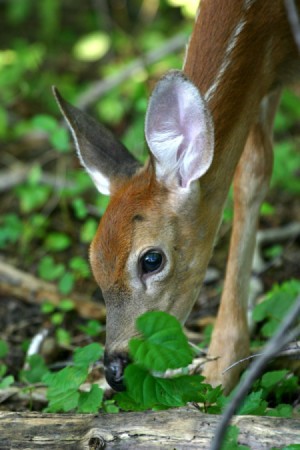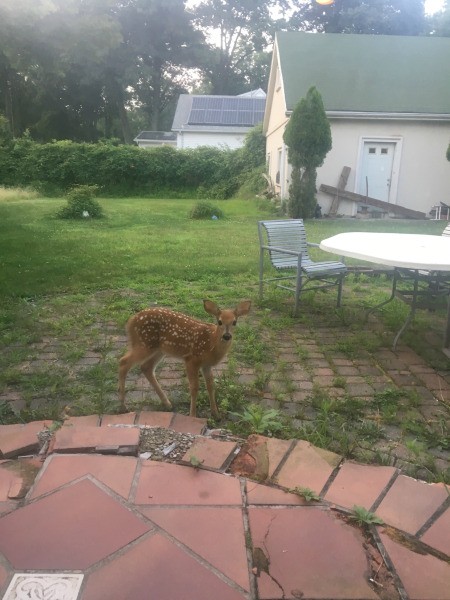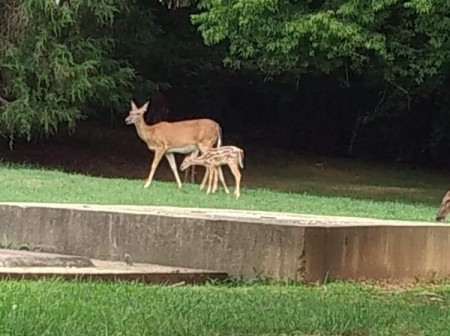 White-tailed deer mate in the fall from October to early December. Their babies, called fawns, are born approximately seven months later in the early spring or summer. White-tailed deer are considered a uniparental speciesmeaning the fawns are only cared for by one parent (the doe). Shortly before the doe is ready to give birth she chooses a birthing area, a spot covered by vegetation that will help conceal her fawns from predators. Once there, she will drive off any other deer that try to enter the area, even her own offspring. Her existing female offspring may rejoin her and her newborns later on, but the males will either leave voluntarily or be permanently driven off to start life on their own.
White-tailed deer mate in the fall from October to early December. Their babies, called fawns, are born approximately seven months later in the early spring or summer. White-tailed deer are considered a uniparental speciesmeaning the fawns are only cared for by one parent (the doe). Shortly before the doe is ready to give birth she chooses a birthing area, a spot covered by vegetation that will help conceal her fawns from predators. Once there, she will drive off any other deer that try to enter the area, even her own offspring. Her existing female offspring may rejoin her and her newborns later on, but the males will either leave voluntarily or be permanently driven off to start life on their own.
Fawns weigh about 8 pounds at birth and twins are quite common, especially if the doe has been healthy and well-fed throughout her pregnancy. They are helpless at birth, but able to stand and take a few steps within the first hour. Because the blood and fluids at the birthing site may attract predators, as soon as they get to their feet the doe leads the fawn to a new sheltered spot called a form. If she has twins, the doe may place each fawn in a separate form up to 200 feet apart so that if one is discovered by a predator, the second will remain safe. At birth, the fawns reddish-brown coats are dappled with white spots. This makes them nearly invisible to predators while lying motionless among vegetation.
The Fawn's First Year
The fawns will spend their first three to four weeks in the form, or until their wobbly legs grow strong enough to keep up with their mothers. The does dont tend to their fawns nonstop; since her fawns are born odor-free, the doe keeps her distance, except when nursing, to avoid having her own scent draw predators to them. The fawns are born with the instinct to remain still and quiet while their mothers are away. Its common for people to happen upon newborn fawns curled up in a field or forest alone and mistakenly assume they have been orphaned, but that is almost never the case! If this happens to you, enjoy the moment and then quietly move on. Although the fawns mother is probably not visible, it is likely that she is somewhere nearby.
After about three weeks of hiding, the fawns can run fast enough to keep up with their mothers and start following them everywhere. The protective does begin to show their young how to find food, but even after the young start grazing or browsing, they will continue to nurse for some time. Eventually they will rely solely on the foods they will eat as adults: acorns, corn, soybeans, mushrooms, grasses, tree leaves, buds, twigs and bark, wild grapes, apples and assorted shrubs.
Navigating Life on Their Own
White-tailed deer are considered fawns until they are a year old, when they are called yearlings. The death rate among both fawns and yearlings is high. They are killed by predators (wolves, coyotes, bears, and bobcats) bad weather, disease, or a lack of maternal care if their mother is killed or abandons them. Researchers have estimated that as many as 30% to 40% of white-tailed deer die during their first or second year.
Here are the questions asked by community members. Read on to see the answers provided by the ThriftyFun community.
We have a fenced in yard and noticed a fawn inside about 2 weeks ago. We haven't seen the mother. I am not sure what to do about the fawn.

Wildlife rehabber is what you need. You should be able to find info on them from your state department of environmental conservation website. Do not call the DEC to report the deer. I spoke to my local rehabber about this and she told me that they would put it down and so would the troopers.
We have been watching a pregnant doe for a while and today she brought her new fawn to our backyard. But instead of white spots it has white irregular stripes.
Do they vary according to the age or is this a different species of deer? Thank you.
There is a black striped deer and a white striped deer. Maybe the father is one of those
yes, it sounds like a different species, maybe one not common in your area
It may be that the stripes were the longer "spots" and have extended to form a close line as the fawn ages?
It cannot be from the white-striped deer as their stripes run across the body and not the length of the body.
I would suggest you contact your county extension office (Google with your zip code) and send them the picture to see what their reaction would be.
Also, if you are near a university they might be interested and supply you with an answer.
Neat to have this going on in your back yard - very trusting.
Sweet!!! Like you, we have a ton of deer and babies in our area also!
I agree with cybergrannie to show a photo to your local extension office or ag school.
My thought is it may be an optical illusion of sorts, which I think someone else suggested...that they are the spots, close together and look like a line. You do not want to get close enough to see better or mom may storm at you (my good friend was just "threatened" recently for a totally unintentional threat to a mom and baby). I found a neat article from Penn State about coloring:
ecosystems.psu.edu/
Enjoy them, but be aware of the ticks...our poor pup had Lyme disease from deer ticks....and he only goes out for a few minutes, in our front yard, at the bottom of the steps, 3 times a day to do his business. Scary stuff.
Several years ago I lived in an area that had lots of free roaming deer and I was always seeing the babies following their moms.
The free roaming area belonged to the University of Florida (200 acres) and the deer loved to walk up and down the fence that fronted a highway so that was how we could see so many and especially at night!
Many people (including me) made regular trips just to see these gorgeous animal families. Of course, they somehow knew they were safe and completely ignored us.
The University of Florida has several places where there are free roaming animals - Bison and Antelope for a couple and it makes me feel good knowing these animals have almost nothing to fear and always receive plenty of food and medical needs.
Thanks for posting the photo and keeping us updated.
Check out these photos.
This fawn is a few days old. It was born in our yard, here it is resting under a tree near our house. The Mom is nowhere to be seen. It was found by my wife while picking garlic mustard in our yard.
This adorable baby showed up in our yard last week. Our backyard borders the gamelands, and we have seen adult deer walk down our driveway to graze in the fields across the street. We figured momma deer left the baby in our care, so she could feed and run errands.
While driving along Skyline Drive in Shenandoah National Park a few weeks ago, I was able to capture this Mother Doe and her Fawn posing together ever so nicely in the woods. I couldn't have planned it any better myself.
While out walking, we spotted this baby fawn laying in the grass.
While visiting Shenandoah National Park this weekend, I was so excited to have seen this little baby fawn. It really doesn't get much cuter than this!
I was lucky enough to see this fawn, let alone have it decide to scratch an itch!
We went away for the weekend, and we stopped at Elk Neck State Park in North East Maryland. Along the side of this road was a brave little fawn that didn't seem to notice that we stopped our car right next to her.
Four fawns that learned to eat corn treat. Believe it or not, they have to be taught what to eat by watching their mothers. But they will taste-test numerous flowers and landscape plants on their own. It's odd things they don't know to eat; like tacos, apples, grapes, etc., that they watch their mothers eat it or not.
Here are our new neighbors, mom and baby. This is just one of at least two pairs that live in and around our yard in rural Washington near the Strait of Juan de Fuca. Baby is about a week old now and follows mom very closely everywhere she goes.
Driving down a county road on an early July morning in North Dakota, twin fawns popped up out of the grass in the field to my left as the sound of the gravel beneath my wheels spooked them. The spotted babies looked my way for a moment or two before all the sudden they were bounding away with a destination in mind.
I was riding around in the area where I am considering purchasing a house, and I came upon this fawn. The fawn did not seem to be afraid of the car, so I stopped, and it obliged me by posing for a few pictures!
ThriftyFun is one of the longest running frugal living communities on the Internet. These are archives of older discussions.
I was having my coffee in the sunroom when something caught my eye in the yard.
Since we live on a country road, we get to see a lot of deer in our yards, and since no one is living in their home right now, this little fawn was napping under a Hosta plant.
This is a picture of a baby deer that we found on our property the other day when we went to pick tomatoes.
This little guy lost his footing trying to run after his mom when we drove into our driveway. It only took a few minutes before he was up and reunited with his waiting mother.